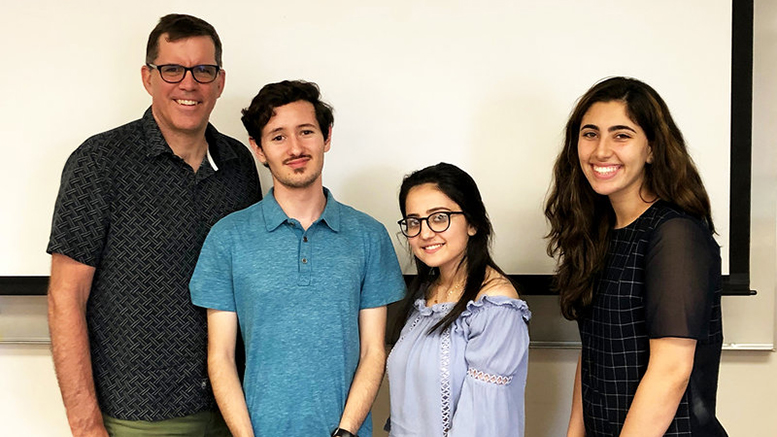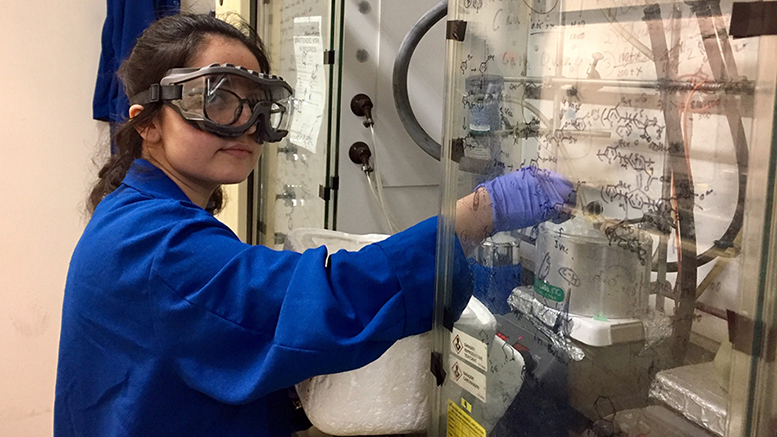After her family immigrated to Southern California from Syria in 2013, Diala Alhousari often pulled all-nighters out of necessity. Getting her homework done required on the spot translation into Arabic and back into English.
A strong work ethic and determination are just two of the attributes that helped Alhousari, now a sophomore at Cerritos College, a community college in southeastern Los Angeles County, land a coveted University of Southern California (USC) Dornsife College of Letters, Arts and Sciences research internship this past summer.
Alhousari was one of three interns selected for the USC-Cerritos College Summer Research Internship in Solar Energy, which gives students a deep dive into USC Dornsife chemistry solar energy research. And they are paid as they work and learn alongside graduate students.
Editor’s note: This article comes from the University of Southern California Dornsife. It is reprinted with permission.
Interns are mentored in groups that design and synthesize new molecules and materials for use in photovoltaic technology and for study by ultrafast laser spectroscopy. They participate in research on improved organic photovoltaic solar cells, how they are tested in devices and new materials, and the physical processes behind them.
A chance for real-life science
Alhousari noted that the hands-on aspect of the eight-week internship — the chance to take lessons out of the classroom and apply them in a real laboratory — appealed to her.
“I like science in general, but I like chemistry specifically because I like to understand the concepts, not just memorize the concepts,” Alhousari said. “All this information is being thrown at you, but as I moved on, step by step, week after week, my understanding improved.”
Alhousari helped build sunlight-absorbing polymers in the lab of Barry Thompson, an associate chemistry professor at USC Dornsife. Thompson’s group uses environmentally sustainable methods to build better organic polymers for use in new-generation materials, such as printable solar cells. The idea is analogous to laying ink on sheets of newsprint to make newspapers, he said.
Flexible materials can be made into rollable solar panels or windows by inserting semi-transparent solar cell layers between panes. Such materials could one day replace bulky, silicon-based solar panels, like those currently adorning many rooftops.

(From left) Cerritos College chemistry professor Jeff Bradbury with Cerritos students Ariel Ramirez, Diala Alhousari and Rachelle Elhessen. (Photo: Richard Brutchey)
After finishing this year at Cerritos as a biology major, Alhousari plans to transfer to a four-year college and hopes to go on to earn a Ph.D. in a science, technology, engineering and math (STEM) field, such as chemistry, in preparation for a research career.
A need in the community
Opportunities for research experience are scarce for community college students, especially the population served by the USC-Cerritos partnership. Cerritos College serves a largely minority population, and 55 percent of the students are first-generation college students. Many can’t afford to sign up for unpaid internships that other college students may rely on to obtain experience in their fields of study.
“A lot of our students are high functioning, high achieving, but they are intimidated about the transition,” said Cerritos chemistry professor Jeff Bradbury, who champions the program and helps recruit and select candidates. He sees up close the hurdles in terms of finances, logistics and self-confidence that can impede students’ ability to make the leap to earning a bachelor’s degree.
The internship was launched in 2010 by chemistry professor Richard Brutchey to provide research experience and promote continued education among underserved student populations. The program is open to science majors who have completed a first-year chemistry course; minorities and women, generally underrepresented in the physical sciences, are especially encouraged to apply. Funds come from participating professors’ individual National Science Foundation research projects, which incorporate programming that will have broader impacts on society.
Raising career expectations
Underscoring the program’s impact, many former interns have pursued further STEM education. The internship “completely changed my life and education goals,” said Alejandro Cuellar-De Lucio, who interned with Thompson in 2015. Born and raised in Tijuana, Mexico, his family settled in Long Beach to build a better life. He finished high school and enrolled in Cerritos College, where Bradbury encouraged him to apply.
“Before (the internship), my education goals, expectations and confidence to do scientific research were very low,” Cuellar-De Lucio said.
Related articles: ‘Research experiences have major benefits‘ and ‘AACC summit focuses on undergraduate research‘
His modest goals quickly changed into more ambitious ones. Eventually, Cuellar-De Lucio transferred to the University of California, Berkeley, where he is on track to complete a baccalaureate in chemistry in May 2020. He is now applying to Ph.D. programs and aims to become a chemistry professor at a research university.
“Completing this internship provided me with the vision, motivation and inspiration to not only pursue higher education but also to pursue a career in science,” he said.
A hot topic
USC Dornsife professors visit Cerritos College’s campus to promote the internship.
“We try to convey just how large an amount of energy is used in the U.S. and globally,” said Thompson, noting that most of that energy is derived from fossil fuels. “We’re trying to paint a picture that there’s a pressing need to deal with this issue.”
Remarkably, he added, more energy reaches the Earth’s surface through solar energy in a single hour than all of the energy currently consumed in a year.
“The sun is the only source of energy that could potentially single-handedly replace fossil fuel energy all by itself. It’s ridiculous, in a way, that it isn’t tapped more.”
The message is an easy sell to young people contemplating Earth’s uncertain future, Thompson said.
Program founder Brutchey is pleased with the progress achieved by the program participants.
“Over 95 percent have transferred to a four-year institution and majored in a STEM discipline, and several of our first interns have pursued graduate studies in chemistry,” said Brutchey.
Judging by the paths taken by many of the 27 students who have completed the internship so far, the future of solar energy conversion looks bright.

